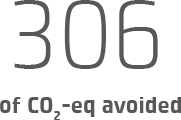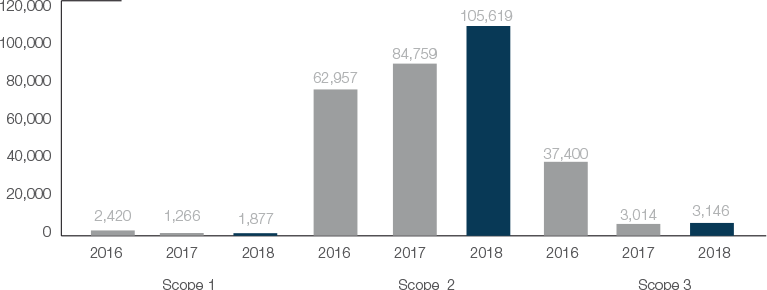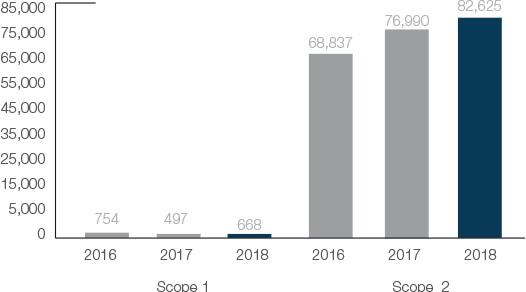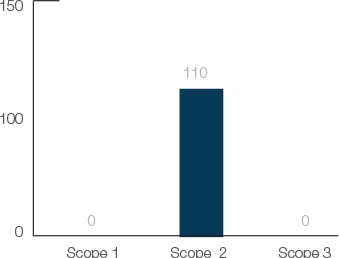Environment
Responsible environmental management
Cellnex bases its activity on the principles of sustainability and responsibility and has therefore defined Sustainable Business Development as one of the basic pillars of its CR Master Plan. This involves the company committing to sustainability, environmental preservation and efficiency by setting goals, and more specifically by implementing concrete actions and programmes for all the companies of the Group.
As such the company has an Environmental Policy based on respecting the environment, protecting and preserving biodiversity, using renewable energies, mitigation and adaptation to climate change, and contributing to sustainable development through the efficient use of resources, as well as promoting preventive and mobility actions.
The Sustainable Business Development pillar is defined on the basis of the following goals, each of which consists of several specific actions:
- Putting environmental management of Cellnex in Spain at the same level as the rest of the companies in the Cellnex group;
- Promoting energy efficiency, increasing the use of renewable energy as much as possible and fostering the implementation of efficiency measures at the company’s premises;
- Committing to sustainable mobility;
- Developing a carbon management framework in Spain to include the strategic perspectives to be worked on and focused on a set of actions, framed in different lines of management, that must be approved, funded and implemented to achieve the carbon management objectives established;
- Minimising the risks and fostering the business opportunities derived from climate change identified in relation to Cellnex Telecom’s activity in Spain;
- Progressively reducing the carbon footprint in Spain, Italy and France;
- Protecting and respecting the ecosystems affected by Cellnex’s activity;
- Promoting a sustainable culture within the Cellnex organisation; measuring and communicating environmental performance and reporting this on an annual basis in international organisations (CDP, GRI, DJSI, UNGC, FTSE, etc.).
The organisation’s environmental objectives defined in 2018 set out 31 goals for improving or mitigating environmental impacts. Twenty-four of these have been implemented, while the remainder are almost implemented or in the process of completion.
Monitoring and managing the main risks, opportunities and environmental impacts
Within the environmental management system already implemented and certified, Cellnex Spain periodically updates the identification and evaluation of its environmental aspects, risks and opportunities related to the company’s activity and its derived environmental impacts, as well as the significance criteria.
The most significant impacts are extracted from these evaluations, to which end a monitoring system is established and actions are planned to mitigate them. Efficiency and management actions are performed according to the type of impact and are related to energy and biodiversity respectively.
Energy
Cellnex monitors the organisation’s energy consumption to achieve maximum efficiency and the lowest possible impact on the environment and hence on society.
Most of Cellnex’s electricity consumption comes from its sites and, to a lesser extent, its offices. In 2018, the company’s total electricity consumption was 460,972,053 kWh.
DISTRIBUTION OF THE ELECTRICITY CONSUMPTION

Cellnex is committed to using renewable energies, as borne out by Cellnex Netherlands practice of buying 100% green energy and Cellnex UK’s target to follow suit in 2019.
Cellnex Spain has photovoltaic power generation facilities for electricity use on its own sites, which generated 62,014 kWh in 2018, thereby contributing to reducing 24.19 t CO2 of the company’s carbon footprint.
In addition, the fuel consumed by the company’s vehicle fleet and emergency generators on sites was 7,693,453kWh in 2018. Natural gas is used only at the Cellnex headquarters in Barcelona and in 2018 amounted to 11,061 kWh.
DIESEL CONSUMPTION PER COUNTRY [KWH]

Energy efficiency
Throughout 2018, Cellnex continued working to achieve more efficient procedures and perform initiatives to reduce energy consumption This objective focuses primarily on improving equipment and implementing technologies that increase efficiency, applied in two different approaches: products and services provided by the company and Cellnex’s own offices and centres.
One of the main energy efficiency measures that we have implemented on sites is a type of cooling system that consumes less energy by using external air to chill water for more efficient air conditioning than traditional systems. The free cooling system has already been installed on numerous sites in Spain, Italy and the Netherlands. In Italy the goal is to install this system in 1,000 sites by 2020 - equivalent to 30% of all sites in the country where it has the potential to be installed.
In addition, in Cellnex Spain, measures have been taken to reduce energy consumption, such as the renewal of uninterrupted power supply systems (UPS) by more efficient ones, the replacement of luminaires and the modification of tariffs, which without reducing consumption have managed to reduce the associated cost.
On the other hand, Cellnex France has opted for a fleet of 100% hybrid vehicles minimising the damage to the environment and to human health.
In Cellnex Spain, during 2018, the above energy-efficiency projects enabled savings of 781 MW, which equals to 306 of CO2-eq.
It is worth noting that HIVOS (a Dutch non-profit organisation for human development) named Alticom, a Cellnex Netherlands subsidiary, one of the most sustainable Data Centre providers in the country because of its energy efficiency measures in 2014, 2015 and again in 2018.
ENERGY-EFFICIENCY PROJECTS

Other relevant projects that entailed energy savings in 2018 were:
- Installing wall and ceiling fans in On Tower centres with compact air conditioning.
- Implementing several specific energy-saving projects in Collserola Tower, including: installing a solar filter on all glass surfaces to improve closures; replacing the lighting system (fluorescent) with LED lighting; installing heat monitoring and control systems and recorders for automatic temperature activation and recording equipment energy consumption, and moving transformers to rooms that do not require air conditioning.
- Replacing separator transformers with passive protection without losses for transient and permanent voltage in some Cellnex centres.
Carbon footprint
As part of the Environmental Policy, an initial diagnosis and an analysis of risks and opportunities related to climate change in the company’s activities was performed in 2017. The results of this first phase were used to draft the Cellnex Spain Carbon Management Plan in 2017, which aims to reduce greenhouse gas emissions of the company and sets out individual measures and priorities in tackling climate change. This plan was approved in 2018.
Once again this year, Cellnex measured and obtained independent third-party confirmation of its carbon footprint, to ascertain the company’s impact on climate change and to identify the baseline for managing and reducing its emissions. This year, for the first time and as part of the country integration programme for the various countries, in addition to calculating the carbon footprint of Spain and Italy, we also calculated that of Cellnex France.
In 2018, the GHG emissions from Cellnex Spain, Italy and France were calculated according to the financial control approach. The company reported all GHG emissions attributable to the operations it controls. Cellnex Spain: Tradia, Retevisión, Ontower and Cellnex corporate; Cellnex Italy: Galata and TowerCo; Cellnex France: Towerlink.
The operational scope is based on the following criteria:
- Scope 1: covers GHG emissions that are directly under Cellnex control.
- Scope 2: covers indirect GHG emissions associated with the electricity consumption of Cellnex’s own facilities.
- Scope 3: this takes into account indirect GHG emissions resulting from the organisation’s activities but which are generated in sources owned or controlled by another organisation. To calculate scope 3 emissions, the following categories defined in the ‘Corporate Accounting and Reporting Standard (scope 3)’ were taken into account:
- Purchase of goods and services: emissions from water and paper consumption.
- Third-party upstream transport and distribution: from road, plane and/or sea travel by third parties paid by Cellnex.
- Waste generation: emissions linked to managing waste fractions with a contribution of over 1%.
- Corporate travel: linked to related air travel, taking into account the characteristics of flights taken by Cellnex staff.
- End-of-life of products sold: waste management at the end of the useful life of products that account for at least 1% of the total, provided that the sum of those excluded does not exceed 5% of the total.
CELLNEX SPAIN EMISSIONS(t. CO2 e)(2)

CELLNEX ITALY EMISSIONS (t. CO2 e)(1)

CELLNEX FRANCE EMISSIONS (t. CO2 e)(3)

(1) In Cellnex Italy, scope 3 emissions were not calculated.
(2) For the calculation of GHG emissions, it has not been possible to include the emissions derived from the leakage of refrigerant gases in scope 1 due to lack of information related to the air conditioning equipment, although an attempt will be made to obtain the information for the calculation of next year’s carbon footprint. For the calculation of GHG emissions of scope 2, emissions derived from electricity consumption have been considered.
(3) In Cellnex France, scope 1 and 3 emissions were not calculated.
 As part of its efforts to manage greenhouse gas emissions, in 2018 Cellnex in Spain offset 1,877 tCO2 by purchasing 1,877 VER (Verified Emissions Reductions) credits on the voluntary market from the Mariposas Project in Chile, with the Verified Carbon Standard (VCS), to achieve neutrality in Scope 1 carbon footprint emissions.
As part of its efforts to manage greenhouse gas emissions, in 2018 Cellnex in Spain offset 1,877 tCO2 by purchasing 1,877 VER (Verified Emissions Reductions) credits on the voluntary market from the Mariposas Project in Chile, with the Verified Carbon Standard (VCS), to achieve neutrality in Scope 1 carbon footprint emissions.
From a communication and awareness-raising point of view, the company has released several communications of its actions:
- Publication of the company’s carbon footprint report on the Cellnex corporate website.
- Registration in the Footprint Registry of the Spanish Climate Change Office under the Ministry of Agriculture, Food and Environment.
 Joining the Catalan Generalitat’s Voluntary Agreements Programme for reducing greenhouse gas (GHG) emissions. This tool is promoted by the Catalan Office for Climate Change (OCCC) for companies seeking a voluntary commitment to reduce their GHG emissions beyond what regulations stipulate.
Joining the Catalan Generalitat’s Voluntary Agreements Programme for reducing greenhouse gas (GHG) emissions. This tool is promoted by the Catalan Office for Climate Change (OCCC) for companies seeking a voluntary commitment to reduce their GHG emissions beyond what regulations stipulate.- Publication of the withdrawal of the carbon credits from the project selected in the Market Environmental Registry or equivalent as a guarantee of the compensation made.
In addition, Cellnex Spain has drawn up Sustainability Guidebook as a tool for integrating measures in this area for all countries, which will help measure our positioning on the market with regard to other companies in the sector.
Biodiversity
By assessing and monitoring the aspects and impacts of Cellnex Spain, the organisation has identified the Effect on Biodiversity – the environmental impact associated with the loss of biodiversity of living beings and natural species –as one of its significant aspects.
Cellnex manages its facilities so as to minimise any type of environmental impact of its activities that affects biodiversity. It takes into account not only the work of the company itself but also its providers, since their maintenance work and services can have the greatest environmental impact. Cellnex works with its suppliers to ensure they are environmentally responsible and use best practices, for instance by correctly managing waste and protecting biodiversity.
To ensure a proper management of these impacts, it is essential to have a diagnosis of the presence of Cellnex’s activity in areas with greater vulnerability. Specifically, in Spain 58.18% of the sites are within protected areas, while in Italy this figure is 20%.
To control the company’s impact on birds, Cellnex Spain uses signage to identify centres with bird nesting to establish whether a centre does in fact cause such an effect and to remind staff of the preventive measures to be taken into account.
Furthermore, as a key preventive measure to protect the environment, every year Cellnex notifies its employees of the start of the forest fire prevention campaign, when use of machinery that may cause a fire is restricted on company facilities.
DaMA programme
Cellnex uses the DaMA (environmental data server) tool to display geographical data and identify declared natural protection sites in the country, information that is also found in the GESEM database. The server also provides access to environmental data relating to Cellnex Spain’s sites.
Electromagnetic emissions
Cellnex Telecom complies with the rules associated with electromagnetic emissions for the general public and its workers. It conducts periodic measurements at technical centres with a permanent staff presence, pursuant to Royal Decree 299/2016. As regards the general public, it ensures compliance with Royal Decree 1066/2001 at all sites in Spain.
The regulatory framework in Italy is stricter and Cellnex Italy works to ensure compliance.
Cellnex works with expert groups in researching the impact of electromagnetic fields and takes part in activities related to assessing, managing and communicating the possible health risks of exposure. Specifically, Cellnex works with a subdivision in a department of DigitalES, the Spanish Association for Digitisation, formed mainly by telecommunications operators and Cellnex, which carries out activities related to radio emissions. This work involves examining issues of legal compliance and proposals for improvement, based on the recommendations of the International Electrotechnical Commission (IEC), in addition to studying 5G emissions.
On the other hand, the former Federal Councillor Doris Leuthard, head of the Department of the Environment, Transport, Energy and Communications (DETEC) in Switzerland, has decided in autumn 2018 to set up a working group to discuss mobile communications and radiation. In particular, the group will analyse the needs and risks of setting up 5G networks and draw up a report with recommendations by mid-2019. As new independent player and with his forward-looking infrastructure model, Cellnex Switzerland is part of the group and is helping to shape the future development of the mobile network. As a member, Cellnex can, through its knowledge and experience, make a significant contribution to the established working group.
In addition, Cellnex is working with epidemiology research groups from ISGlobal (Barcelona Biomedical Research Park) by providing information on emission sources (television, radio, etc.).
GRI: Energy management approach (103-1, 103-2, 103-3), 302-1, 302-2, 302-3, 302-4, 305-5, Emissions management approach (103-1, 103-2, 103-3), 305-1, 305-2, 305-3, 305-5 biodiversity management approach (103-1, 103-2, 103-3), 304-1, 304-2








 As part of its efforts to manage greenhouse gas emissions, in 2018 Cellnex in Spain offset 1,877 tCO2 by purchasing 1,877 VER (Verified Emissions Reductions) credits on the voluntary market from the Mariposas Project in Chile, with the Verified Carbon Standard (VCS), to achieve neutrality in Scope 1 carbon footprint emissions.
As part of its efforts to manage greenhouse gas emissions, in 2018 Cellnex in Spain offset 1,877 tCO2 by purchasing 1,877 VER (Verified Emissions Reductions) credits on the voluntary market from the Mariposas Project in Chile, with the Verified Carbon Standard (VCS), to achieve neutrality in Scope 1 carbon footprint emissions. Joining the Catalan Generalitat’s Voluntary Agreements Programme for reducing greenhouse gas (GHG) emissions. This tool is promoted by the Catalan Office for Climate Change (OCCC) for companies seeking a voluntary commitment to reduce their GHG emissions beyond what regulations stipulate.
Joining the Catalan Generalitat’s Voluntary Agreements Programme for reducing greenhouse gas (GHG) emissions. This tool is promoted by the Catalan Office for Climate Change (OCCC) for companies seeking a voluntary commitment to reduce their GHG emissions beyond what regulations stipulate.